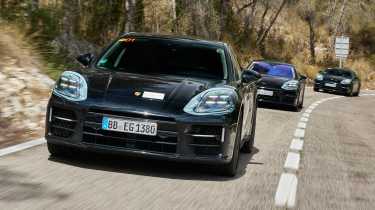2024 Porsche Panamera passenger ride review
The third-generation Porsche Panamera is just around the corner, and we’ve had our first taste from the passenger seat
Porsche’s engineers are finalising the development of an all-new, third-generation Panamera, and we caught up with the test team for a ride in two pre-production prototypes. The company hasn’t released any images of the final design yet, but while the prototypes look very similar to the outgoing car - and the G3 is a similar size and proportion to its predecessor - we’re told the camouflage hides a greater depth of definition to the surfaces that should make the new car a much more distinctive one. We shall see…
In the meantime, what we can say is that the new range starts with a rear-drive V6, expands with four-wheel drive variants, that then become V6 hybrids, and tops off with a new Turbo E-Hybrid that takes the place of the old range-topping purely ICE-powered Turbo. Porsche is fairly tight lipped about the prospect of a new Turbo S E-Hybrid model, but don’t bet against its appearance in due course.
> New Porsche 911 S/T: lightweight special arrives with GT3 RS engine and manual gearbox
It’s quite obviously a Panamera once you’re sat inside, and while there’s some disguise on this V6 4WD model we’re in first, some things are clear. The latest generation switchgear is being shared with the new Cayenne (such as the new infotainment screen), and there are also elements of the Taycan family (the PRND shifter) incorporated. There is now a start button (and a mode switch on the wheel), and no physical key to insert as such, while the driver’s display is completely digital. A secondary screen for the passenger can display video or navigational details, and shutter technology within the screen means that the driver can’t see it when the car is moving.
More reviews
In-depth reviews
Long term tests
Reviews
The V6s are now of the newer, 2.9-litre twin turbo variety - with the single-turbo 3-litre engine being pensioned off - and should have around 345bhp. Despite much effort to contain the weight of the cars, it’s expected that the new models will be around 25kg heavier than those that they replace, partly because every Panamera now runs on air springs as standard, and also down to the insulation material that’s been added to improve NVH. Some of this is in the form of foam applied into areas such as the rear wheel arches, but it’s also through changing the front cross beam from aluminium to foam-filled steel to reduce the amount of noise transmitted through the structure. Certainly, the V6 is very quiet unless called to action, but also seems to give the car a decent turn of speed.
The big news for the new Panamera is the progress that’s been made with the hybrid setups. Porsche has integrated the e-motor into the (now strengthened) gearbox, where they share the same oil cooling circuit, meaning much better temperature control is possible; de-rating before was largely due to heat build up. In the Turbo the new e-motor can contribute up to 140kw, working with a more powerful 25.9kw battery (though it's the same size as before), which means a peak output of around 650bhp and over 660lb ft. As for the V8, it’s an evolution of the old engine but much has been done to enable the car to meet forthcoming emissions regs (it’s not quite euro 7, but not far off). The turbos are no longer of the twin-scroll type, and they’re larger too, but any lag is filled in by the e-motor, of course - and there are new pistons and a revised crankshaft as well. The performance is, naturally, very strong, but the Turbo can also travel over 50 miles on pure electric power alone (and the V6 Hybrid slightly further still).
The other major news is the adoption of new chassis technology that Porsche’s engineers are particularly excited about. Certainly, from our brief experience, the new car can combine very impressive ride quality with real composure when driven hard. As mentioned, all of the models now get air springs as standard, but the setup is down to two chambers (as opposed to three in the old car) because the dampers now have two valves, one for adjusting the bump and one for rebound (the old car had one that could do either/or, but not both at the same time).
The Turbo goes a step further as it has Porsche’s new ‘active’ setup fitted, which does away with the anti-roll bars for no bars at all (PDCC has been dropped). Instead, each wheel now has its own hydraulic pump and is entirely independent of the others, meaning that the two-valve dampers can be fully manipulated depending on driver mode and also data from sensors around the car. In practice, that means the car can stay resolutely flat regardless of load, but at the other extreme, traverse bumps that would seriously trouble a conventional car with very little shock and movement making it through to the cabin. Having experienced it first hand, it’s almost surreal in its capabilities. In addition, there’s a new steering rack and new suspension mountings, amounting to a significant evolution of the Panamera’s chassis.
The G3 Panamera is set to go on sale early next year, and while electrification means the hybrid models are far from lightweight, it’s the only way Porsche has been able to retain its beloved turbocharged engines. On the basis of this first glimpse, the new tech should make for a capable and intriguing car.




